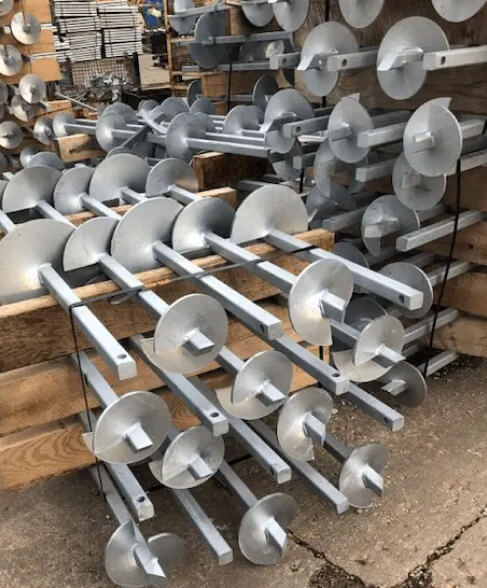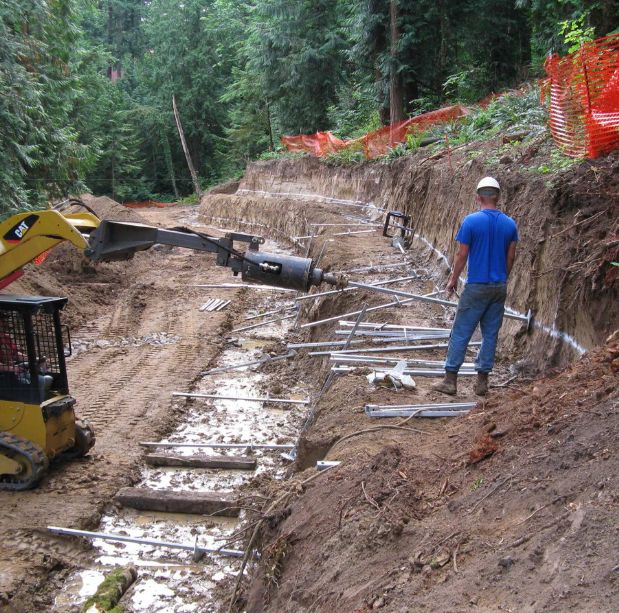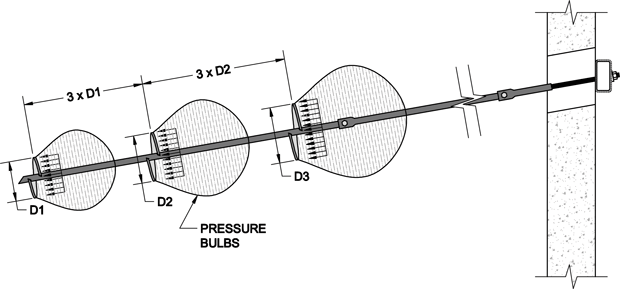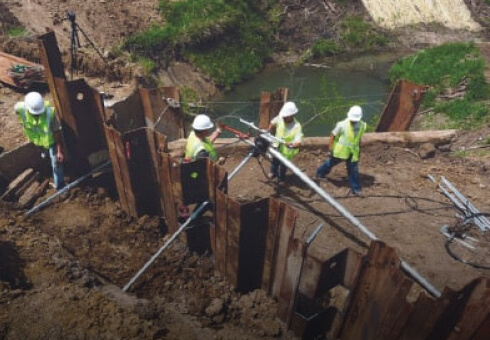COMMERCIAL
hELICAL PILES

Commercial Helical Piles in
Greater Portland
Helical Anchors, Screw Piles & Helical Piers
Helical piles are steel foundation systems manufactured in a factory, consisting of a central shaft with one or more helix-shaped bearing plates, also known as blades or flights, welded to the lead section. Extension shafts, which may or may not have additional helix blades, are used to extend the pile to reach competent load-bearing soils and achieve the desired depth and capacity. Brackets are attached to the tops of the piles to connect them to structures, suitable for both new construction and retrofit applications. Helical piles are installed by screwing them into the ground using torque.
The terms helical piles, screw piles, helical piers, helical anchors, helix piers, and helix anchors are often used interchangeably by specifiers. However, ‘pier’ typically refers to a helical pile loaded in axial compression, while ‘anchor’ usually refers to one loaded in axial tension.
Get a consultation to learn more. TerraFirma serves Oregon and Washington areas throughout Salem, Vancouver, Tacoma, and nearby!
DESIGN CONSIDERATIONS
Helical piles are designed so that most of their axial capacity is generated through the bearing of the helix blades against the soil. The helix blades are typically spaced three diameters apart along the pile shaft to prevent one blade from significantly stressing the bearing soil of the adjacent blade. The significant stress influence is confined to a ‘bulb’ of soil within about two helix diameters from the bearing surface in the axial direction and one helix diameter from the center of the pile shaft in the lateral direction. Consequently, each helix blade acts independently in bearing along the pile shaft.
Multiple piles should have a center-to-center spacing at the helix depth of at least four times the diameter of the largest helix blade (ICC-ES AC358). The tops of the piles may be closer to the ground surface but should be installed at an angle away from each other to meet the spacing criteria at the helix depth. For tension applications, the uppermost helix blade must be installed at a depth of at least twelve diameters below the ground surface (ICC-ES AC358).
Supportworks Model 287 Helical Pile System
Technical Specifications
- Outside Diameter (O.D.) = 2.875″
- Wall Thickness = 0.203″
- Pile Shaft Yield Strength = 60 ksi (min.)
- Coupling Hardware: (2) ¾” Grade 8 Bolts with Nuts
- Available Helix Blade Diameters = 8″, 10″, 12″, and 14″
- Helix Blade Thickness = 0.375″
- New Construction Bracket: ¾” x 6″ Square A36 Plate (for allowable compression capacities up to 60.0 kips)
- New Construction Bracket Hardware: (2) ¾” Grade 8 Bolts with Nut
Technical Specifications
- Bracket: Weldment manufactured from 0.25″, 0.375″, and 0.50″-thick steel plate.Yield strength = 36 ksi (min.), tensile strength = 58 ksi (min.).
- External Sleeve: 3.50″ OD x 0.216″ wall x 30″ long with sleeve collar welded to one end. Yield strength = 50 ksi (min.), tensile strength = 62 ksi (min.).
- Bracket Cap: 5.0″ wide x 9.0″ long x 1″ thick plate with confining ring welded to one side. Yield strength = 50 ksi (min.), tensile strength = 65 ksi (min.).
- All-Thread Rod: 0.75″ diameter x 16″ long, zinc plated. Grade B7, tensile strength = 125 ksi (min.).
Supportworks Model 288 Helical Pile System
Technical Specifications
- Outside Diameter (O.D.) = 2.875″
- Wall Thickness = 0.276″
- Pile Shaft Yield Strength = 60 ksi (min.)
- Coupling Hardware: (2) ¾” Grade 8 Bolts with Nuts
- Available Helix Blade Diameters = 8″, 10″, 12″, and 14″
- Helix Blade Thickness = 0.375″
- New Construction Bracket: ¾” x 6″ Square A36 Plate (for allowable compression capacities up to 60.0 kips)
- New Construction Bracket Hardware: (2) ¾” Grade 8 Bolts with Nut
Technical Specifications
- Bracket: Weldment manufactured from 0.25″, 0.375″, and 0.50″-thick steel plate.
Yield strength = 36 ksi (min.), tensile strength = 58 ksi (min.). - External Sleeve: 3.50″ OD x 0.216″ wall x 30″ long with sleeve collar welded to one end.
Yield strength = 50 ksi (min.), tensile strength = 62 ksi (min.). - Bracket Cap: 5.0″ wide x 9.0″ long x 1″ thick plate with confining ring welded to one side.
Yield strength = 50 ksi (min.), tensile strength = 65 ksi (min.). - All-Thread Rod: 0.75″ diameter x 16″ long, zinc plated. Grade B7, tensile strength = 125 ksi (min.).
Supportworks Model 349 Helical Pile System
Technical Specifications
- Outside Diameter (O.D.) = 3.500″
- Wall Thickness = 0.300″
- Pile Shaft Yield Strength = 60 ksi (min.)
- Coupling Hardware: (4) – Ø1″ Grade 8 Bolts with Nuts
- Available Helix Blade Diameters = 8″, 10″, 12″, and 14″
- Helix Blade Thickness = 0.375″
- New Construction Bracket: ¾” x 6″ Square A36 Plate (for allowable compression capacities up to 60.0 kips)
- New Construction Bracket Hardware: (2) ¾” Grade 8 Bolts with Nut
Technical Specifications
- Bracket: Weldment manufactured from 0.25″, 0.375″, and 0.50″-thick steel plate.
Yield strength = 36 ksi (min.), tensile strength = 58 ksi (min.). - External Sleeve: 3.50″ OD x 0.216″ wall x 30″ long with sleeve collar welded to one end.
Yield strength = 50 ksi (min.), tensile strength = 62 ksi (min.). - Bracket Cap: 5.0″ wide x 9.0″ long x 1″ thick plate with confining ring welded to one side.
Yield strength = 50 ksi (min.), tensile strength = 65 ksi (min.).
Supportworks Model 350 Helical Pile System
Technical Specifications
- Outside Diameter (O.D.) = 3.5″
- Wall Thickness = 0.313″
- Pile Shaft Yield Strength = 65 ksi (min.)
- Coupling Hardware: (4) 1″ Grade 8 Bolts with Nuts
- Available Helix Blade Diameters = 8″, 10″, 12″, and 14″
- Helix Blade Thickness = 0.375″
- New Construction Bracket: ¾” x 6″ Square A36 Plate (for allowable compression capacities up to 60.0 kips)
Technical Specifications
- Bracket: Weldment manufactured from 0.25″, 0.375″, and 0.50″-thick steel plate.
Yield strength = 36 ksi (min.), tensile strength = 58 ksi (min.). - External Sleeve: 3.50″ OD x 0.216″ wall x 30″ long with sleeve collar welded to one end.
Yield strength = 50 ksi (min.), tensile strength = 62 ksi (min.). - Bracket Cap: 5.0″ wide x 9.0″ long x 1″ thick plate with confining ring welded to one side.
Yield strength = 50 ksi (min.), tensile strength = 65 ksi (min.). - All-Thread Rod: 0.75″ diameter x 16″ long, zinc plated. Grade B7, tensile strength = 125 ksi (min.).
Supportworks Model 450 Helical Pile System
Technical Specifications
- Outside Diameter (O.D.) = 4.5″
- Wall Thickness = 0.337″
- Pile Shaft Yield Strength = 70 ksi (min.)
- Coupling Hardware: (4) 1‐1/8″ Grade 8 Bolts with Nuts Finish
- Available Helix Blade Diameters = 8″, 10″, 12″, and 14″
- Helix Blade Thickness = ASTM A572 Grade 50 x 3/8″ Thick
- New Construction Bracket: ¾” x 6″ Square A36 Plate (for allowable compression capacities up to 60.0 kips)
Technical Specifications
- Bracket: Weldment manufactured from 0.25″, 0.375″, and 0.50″-thick steel plate.
Yield strength = 36 ksi (min.), tensile strength = 58 ksi (min.). - External Sleeve: 3.50″ OD x 0.216″ wall x 30″ long with sleeve collar welded to one end.
Yield strength = 50 ksi (min.), tensile strength = 62 ksi (min.). - Bracket Cap: 5.0″ wide x 9.0″ long x 1″ thick plate with confining ring welded to one side.
Yield strength = 50 ksi (min.), tensile strength = 65 ksi (min.). - All-Thread Rod: 0.75″ diameter x 16″ long, zinc plated. Grade B7, tensile strength = 125 ksi (min.).
Helical Pile Capacities Summary
| Helical Pile Capacities Summary | |||||
|---|---|---|---|---|---|
|
Maximum Allowable Mechanical Shaft Capacities (3,5) |
|||||
|
Default Torque Correlation Factor (6) Kt (ft-1) |
Maximum Installation Torque (ft-lbs) |
Maximum Ultimate Torque Correlated Soil Capacity
(6,7)Qu = Kt X T (kips) |
Axial Compression (kips) | Axial Tension (kips) | |
|
HA150 |
10 |
6,500 |
65.0(8) |
26.5(1,8) |
26.5(1) |
|
HA175 |
10 |
10,000 |
100.0(8) |
65.7(8) |
53.0(1) |
|
HP287 |
9 |
5,600 |
50.4 |
46.4(4) |
23.6(2) |
|
HP288 |
9 |
7,900 |
71.1 |
65.4(4) |
34.1(2) |
|
HP350 |
7 |
16,000 |
112.0 |
107.8(4) |
62.5(5) |
- Governed by AISC allowable capacity of single Ø3/4″ (HA150) or (2) Ø3/4″ (HA175) Grade 8 bolt(s) in double shear.
- Governed by bearing at the bolt holes.
- Capacities include a scheduled loss in steel thickness due to corrosion for black, uncoated steel. Scheduled thickness losses are for a period of 50 years and are in accordance with ICC-ES AC358.
- Allowable compression capacities are based on continuous lateral soil confinement in soils with SPT blow counts ≥ 4.Piles with exposed unbraced lengths or piles placed in weaker or fluid soils should be evaluated on a case by case basis by the project engineer.
- Listed mechanical capacities are for the shaft only. System capacities should also not exceed the installed torquecorrelated capacity or those listed in the respective bracket capacity tables.
- Listed default Kt factors are widely accepted industry standards. They are generally conservative and are consistent with those listed in ICC-ES AC358. Site-specific K t factors can be determined for a given project with full-scale load testing.
- Soil capacities listed are ultimate values at maximum installation torque. Allowable soil capacity values are obtained by dividing the ultimate values by the appropriate factor of safety (FOS). FOS is most commonly taken as 2.0, although a higher or lower FOS may be considered at the discretion of the helical pile designer or as dictated by local code requirements.
- Square shaft piles may be considered for compression applications in soil profiles that offer sufficient continuous lateral support; e.g., in soils with SPT blow counts ≥ 10. Even in these higher strength soil conditions, buckling analyses should be considered, taking into account discontinuities and potential eccentricities created by the couplers
Determination of Capacity
The ultimate capacity of a helical pile can be calculated using the traditional bearing capacity equation:
Qu = ∑ [Ah (cNc + qNq)]
Where:
Qu = Ultimate Pile Capacity (lb)
Ah = Area of Individual Helix Plate (ft2)
c = Effective Soil Cohesion (lb/ft2)
Nc = Dimensionless Bearing Capacity Factor = 9
q = Effective Vertical Overburden Pressure (lb/ft2)
Nq = Dimensionless Bearing Capacity Factor
For short-term and transient load applications, total stress parameters should be used. For long-term and permanent load applications, effective stress parameters are recommended. Typically, a factor of safety of 2 is applied to determine the allowable soil bearing capacity, especially if torque is monitored during installation.
Designing a helical pile foundation requires considering various factors, similar to other deep foundation alternatives. Supportworks advises that the design be carried out by an experienced geotechnical engineer or another qualified professional.
Another widely accepted method for estimating helical pile capacity involves correlating it to installation torque. The torsional resistance generated during installation reflects soil shear strength and can be related to the pile’s bearing capacity.
Qu = KT
Where:
Qu = Ultimate Pile Capacity (lb)
K = Capacity to Torque Ratio (ft-1)
T = Installation Torque (ft-lb)
The capacity-to-torque ratio is not a constant and varies with soil conditions and the size of the pile shaft. Load testing with the proposed helical pile and helix blade configuration is the most accurate way to determine project-specific K-values. However, ICC-ES AC358 provides default KK-values for different pile shaft diameters, which can be used conservatively for most soil conditions. For the Model 288 Helical Pile System (2 7/8-inch diameter), the default is K=9 ft−1.

Commercial Helical Anchors / Tiebacks
Screw Anchor and Soil Nailing in Oregon and Washington
Helical Anchors, also known as tiebacks, provide lateral stability to foundation walls and retaining walls that experience unbalanced earth pressures. They can be installed using various equipment such as hand-held tools, mini-excavators, skid steers, backhoes, trackhoes, or crane-supported rigs, allowing for installation in a wide range of applications. This versatility, combined with the ability to load and test the anchors immediately, makes helical anchors a convenient and economical solution for many projects.
Advantages
- Predictable Capacity: The helix blade configuration is selected to achieve the desired embedment and capacity.
- All-Weather Installation: Helical anchors can be installed in any weather conditions.
- Limited or Tight Access Installation: Suitable for areas with restricted access.
- No Spoils Generated: The installation process does not produce soil spoils.
- Clean Installation: No messy grout is involved.
- Immediate Load Testing: Load tests can be conducted right after installation.
- Corrosion Protection: Available with optional hot-dip galvanizing for enhanced corrosion resistance.

DESIGN CONSIDERATIONS
Helical anchors are factory-manufactured steel foundation systems featuring a central shaft with one or more helix-shaped bearing plates, commonly known as blades, welded to the lead section. Extension shafts, with or without additional helix plates, are used to extend the anchor into competent load-bearing soils. Helical anchors are installed by screwing them into the ground using torque.
The terms helical piles, screw piles, helical piers, helical anchors, helix piers, and helix anchors are often used interchangeably by specifiers. However, the term “pier” more commonly refers to a helical foundation system loaded in axial compression, while “anchor” more often refers to a helical foundation system loaded in axial tension.
Supportworks Model 150 helical Pile System
Technical Specifications
- Outer Dimensions = 1.50″ x 1.50″
- Anchor Shaft Yield Strength = 90 ksi (min.)
- Coupling Hardware: ¾” Grade 8 Bolt with Nut
- Available Helix Blade Diameters = 6″, 8″, 10″, 12″ and 14″
- Helix Blade Thickness = 0.375″
- Termination Hardware: 1″ Threaded Rod, Tensile Strength = 120 ksi (min.)
Supportworks Model 175 Helical Pile System
Technical Specifications
- Outer Dimensions = 1.75″ Round Corner Square Bar
- Anchor Shaft Yield Strength = 90 ksi (min.)
- Coupling Hardware: (2) ¾” Grade 8 Bolt with Nut
- Available Helix Blade Diameters = 6″, 8″, 10″, 12″ and 14″
- Helix Blade Thickness = 0.375″
- Termination Hardware: 1″ Threaded Rod, Tensile Strength = 120 ksi (min.)
Helical Pile Capacities Summary
| Capacities Summary | |||||
|---|---|---|---|---|---|
|
Maximum Allowable Mechanical Shaft Capacities (3,5) |
|||||
|
Default Torque Correlation Factor (6) Kt (ft-1) |
Maximum Installation Torque (ft-lbs) | Maximum Ultimate Torque Correlated Soil Capacity (6,7)Qu = Kt X T (kips) |
Axial Compression (kips) | Axial Tension (kips) | |
|
HA150 |
10 |
6,500 |
65.0(8) |
26.5(1,8) |
26.5(1) |
|
HA175 |
10 |
10,000 |
100.0(8) |
65.7(8) |
53.0(1) |
|
HP287 |
9 |
5,600 |
50.4 |
46.4(4) |
23.6(2) |
|
HP288 |
9 |
7,900 |
71.1 |
65.4(4) |
34.1(2) |
|
HP349 |
7 |
13,000 |
91.0 |
88.7(4) |
50.8(2) |
|
HP350 |
7 |
16,000 |
112.0 |
107.8(4) |
62.5(5) |
- Governed by AISC allowable capacity of single Ø3/4″ (HA150) or (2) Ø3/4″ (HA175) Grade 8 bolt(s) in double shear.
- Governed by bearing at the bolt holes.
- Capacities include a scheduled loss in steel thickness due to corrosion for black, uncoated steel. Scheduled thickness losses are for a period of 50 years and are in accordance with ICC-ES AC358.
- Allowable compression capacities are based on continuous lateral soil confinement in soils with SPT blow counts ≥ 4.Piles with exposed unbraced lengths or piles placed in weaker or fluid soils should be evaluated on a case by case basis by the project engineer.
- Listed mechanical capacities are for the shaft only. System capacities should also not exceed the installed torque correlated capacity or those listed in the respective bracket capacity tables.
- Listed default Kt factors are widely accepted industry standards. They are generally conservative and are consistent with those listed in ICC-ES AC358. Site-specific K t factors can be determined for a given project with full-scale load testing.
- Soil capacities listed are ultimate values at maximum installation torque. Allowable soil capacity values are obtained by dividing the ultimate values by the appropriate factor of safety (FOS). FOS is most commonly taken as 2.0, although a higher or lower FOS may be considered at the discretion of the helical pile designer or as dictated by local code requirements.
- Square shaft piles may be considered for compression applications in soil profiles that offer sufficient continuous lateral support; e.g., in soils with SPT blow counts ≥ 10. Even in these higher strength soil conditions, buckling analysis should be considered, taking into account discontinuities and potential eccentricities created by the couplers
Determination of Capacity
The ultimate capacity of a helical anchor may be calculated using the traditional bearing capacity equation:
Qu = ∑ [Ah (cNc + qNq)]
| Where: |
|
For short-term and transient load applications, total stress parameters should be used, while effective stress parameters are more appropriate for long-term, permanent load applications. A factor of safety of 2 is commonly employed to establish the allowable soil bearing capacity, particularly when torque is monitored during the helical anchor installation process.

Like other deep foundation alternatives, there are many factors to be considered in designing a helical anchor foundation. Supportworks recommends that helical anchor design be completed by an experienced geotechnical engineer or other qualified professional.
Another well-documented and accepted method for estimating helical anchor capacity is by correlating it to installation torque. Simply put, the torsional resistance generated during helical anchor installation serves as a measure of soil shear strength and can be directly related to the anchor’s bearing capacity.
Qu = KT
| Where: |
|
The capacity to torque ratio is not a constant and varies with soil conditions and the size of the anchor shaft. Load testing using the proposed helical anchor and helix blade configuration is the best way to determine project-specific K-values. However, ICC-ES AC358 provides default K-values for varying anchor shaft sizes, which may be used conservatively for most soil conditions. The default value for the Model 150 Helical Anchor System (1.50″ square shaft) is K = 10 ft-1.
Helix Blade Geometry
Supportworks’ helical anchors feature blades manufactured with a true helix shape that conforms to the geometry criteria of ICC-ES AC358. In a true helix shape, the leading and trailing edges of the blades are within one-quarter inch of parallel to each other, and any radial measurement across the blade is perpendicular to the anchor shaft. A true helix shape, along with proper alignment and spacing of the blades, is critical to minimizing soil disturbance during installation.
Blades that do not have a true helix shape often have a ‘duckbill’ appearance. These plates create significant soil disturbance and do not conform to the helix geometry requirements of ICC-ES AC358, as their torque-to-capacity relationships are not well documented.

CONTACT A COMMERCIAL
FOUNDATION EXPERT!
TERRAFIRMA IN ACTION
When it comes to commercial foundation and concrete solutions, expertise and certain outcomes are mission-critical.
TerraFirma’s track record with ODOT highways, bridges, the Portland Airport, schools, and various industrial facilities
demonstrates the trust we’ve built across Oregon and Washington. View examples of our commercial work here.



